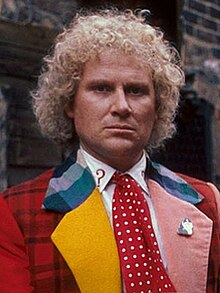This article needs additional citations for verification. (January 2019) |
| The Sixth Doctor | |
|---|---|
| Doctor Who character | |
 Colin Baker as the Sixth Doctor | |
| First regular appearance | The Twin Dilemma (1984) |
| Last regular appearance | The Trial of a Time Lord: The Ultimate Foe (1986) |
| Introduced by | John Nathan-Turner |
| Portrayed by | Colin Baker |
| Preceded by | Peter Davison (Fifth Doctor) |
| Succeeded by | Sylvester McCoy (Seventh Doctor) |
| Information | |
| Tenure | 22 March 1984 – 6 December 1986 |
| No of series | 3 |
| Appearances | 8 stories (31 episodes) |
| Companions | |
| Chronology | |
The Sixth Doctor is an incarnation of the Doctor, the protagonist of the British science fiction television series Doctor Who. He is portrayed by Colin Baker. Although his televisual time on the series was comparatively brief and turbulent, Baker has continued as the Sixth Doctor in Big Finish's range of original Doctor Who audio adventures.
Within the series' narrative, the Doctor is a centuries-old alien Time Lord from the planet Gallifrey who travels in time and space in the TARDIS, frequently with companions. At the end of life, the Doctor regenerates; as a result, the physical appearance and personality of the Doctor changes. Baker portrays the sixth such incarnation: an arrogant and flamboyant character in brightly coloured, mismatched clothes whose brash and often patronising personality set him apart from all his previous incarnations. Preceded in regeneration by the Fifth Doctor (Peter Davison), he is followed by the Seventh Doctor (Sylvester McCoy).
The Sixth Doctor appeared in three seasons. His appearance in the first of these was at the end of the final episode of The Caves of Androzani which featured the regeneration from the Fifth Doctor and thereafter in the following serial The Twin Dilemma, the end of that season. The Sixth Doctor's era was marked by the decision of the BBC controller Michael Grade to put the series on an 18-month "hiatus" between seasons 22 and 23, with only one new Doctor Who story, Slipback, made on radio during the hiatus, broadcast as 6 parts (at 10 minutes each) on BBC Radio 4 from 25 July to 8 August 1985, as part of a children's magazine show called Pirate Radio Four. Colin Baker had been signed up for four years,[1] as the previous actor Peter Davison had left after only three years. Due to his decidedly short screen time, the Sixth Doctor appeared with only two companions, most notably the American college student Peri Brown (Nicola Bryant), who had travelled with his previous incarnation, before being briefly joined by Mel Bush (Bonnie Langford), a computer technician from his future who he had yet to actually meet during his trial.
Prior to its postponement, season 23 was well advanced with episodes already drafted and in at least one case distributed to cast and production. Alongside "The Nightmare Fair", "The Ultimate Evil", "Mission to Magnus", "Yellow Fever and How to Cure It", the remaining stories were still under development in a 25-minute episode format after the season was postponed. These were all dropped with the reconception of the season in mid 1985 in favour of the 14-episode story arc The Trial of a Time Lord.[2] The Sixth Doctor also appeared in the special Dimensions in Time. There are also novels and audio plays featuring the Sixth Doctor, and the character has been visually referenced several times in the revived 2000s production of the show.
More so than any other canonical incarnation, aside from the Eighth Doctor, the Sixth Doctor has been heavily expanded upon in expanded universe media, most notably in audio stories produced by Big Finish Productions. In The Marian Conspiracy (2000), a new companion was introduced - Dr. Evelyn Smythe, a middle-aged history lecturer on the verge of compulsory retirement whose sharp tongue and unwillingness to tolerate the Doctor's attitude steadily taught him to rein in his more unkind tendencies. Due to this influence, the Sixth Doctor evolved into a more compassionate and likable character. In addition, beginning with the webcast Real Time (2003), his costume was revised into a monochromatic blue variant, displayed on many audio stories' covers since then.
- ^ Howe, Stammers & Walker (1993).
- ^ Howe, Stammers & Walker (1993), pp. 207–208.